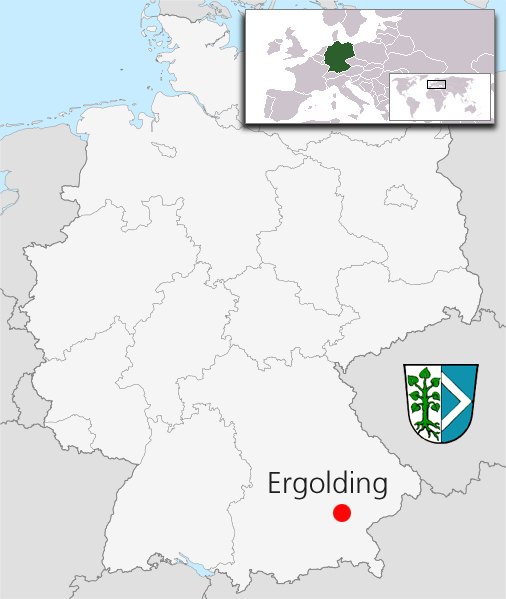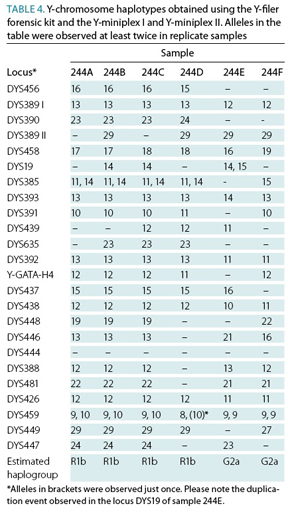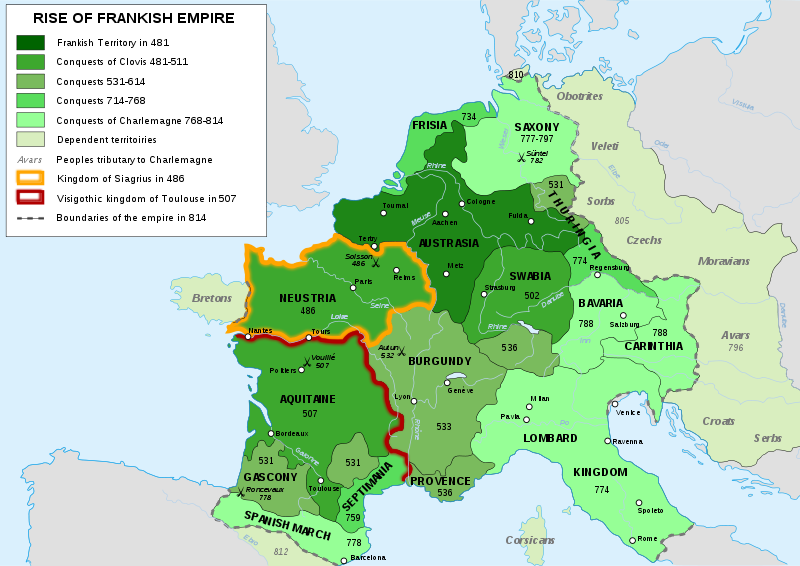Ergolding, Germany - Archaeology Meets FTDNA - Overview
I’ve been following an interesting DNA study over the past several months and it has proven incredibly rewarding for our family DNA study.

This is really the story of a unique testing method in which the DNA
was replicated using a technique which made it possible for enough
YDNA material to be extracted so as to compare to the FTDNA database of
folks like us.
Using their
unique extraction method, the group found the following –
The process turned up 24 markers, many of them were the more stable
alleles.

Of the 6
skeletons tested, 4 were of the R1b Haplogroup (including SNPs of S21
and AMH). 2 were of the G2a Haplogroup. It’s unusual to find
this later group in this part of
What Their DNA Results Tell Us
Three of these skeletons are fitting
nicely into
the S21 group. 244a, 244b and 244c are all showing these markers.
Unfortunately, they aren't yet tested for the "Null 425" marker and
they've not yet been SNP tested for U106 (both important for our S21
understanding). If these skeletons end up matching on those
tests, then we'll know they share ancestors somewhere in northwestern
Europe - Belgium, the Netherlands or northern Germany.3
Family Tree DNA's Forum on this group was early in spotting the
connection to their DNA and has kept up a steady stream of postings on
the developments. Mike Maddi, the group's leader wrote,
“Since
DYS492=13 is a st[r]ong indicator of R1b-U106 and subclades and
DYS492=12
is a strong indicator of R1b-P1312 and subclades, it looks like there's
a 50/50 chance for these medieval Germans to belong to either R1b
subclade. However, given the DYS390=23 and DYS447=24 signature that was
found in the remains, I think it's more likely that the remains belong
to men who were R1b-U106 and more specifically R1b-L48.” 4
I've
found that 12 of our S21 participants match these markers very closely.
244d is directly matching the earlier
Atlantic
Modal Haplogroup but is a distance of 3 off the Super Western Atlantic
Modal Haplogroup(SWAMH) (on DYS456, 458 and 459). You can see the SWAMH
on Ysearch.org using this kit # to bring up the results
- C7BED
The AMH and SWAMH are from the western seaboard of Europe
against the Atlantic Ocean and English Channel. They were incredibly
successful at breeding and very populous.
I've
found that our AMH participants match the 244d skeleton very closely.
Skeletons 244e and 244f are both in
the G2a
Haplogroup. This group seems to be associated with the Sarmatian
people, a horse culture of the Steppes.
I've
found that our G2a participants match these markers very
closely.
With DNA plus Archaeology plus Geography, we can now pinpoint some of our ancestors (or at least some of our cousins) into a known location at a known time. We know other things as well. We know they were buried together and not as in a mass grave after battle. The two G2a skeletons had specific garb which likely signified status as soldiers. We know they represented at least two very different cultures and not just in DNA. It may be that the AMH man and the S21 men didn't know they weren't closely related. Perhaps they were of the same Germanic tribe.
DNA Plus Archaeology = Complete Understanding, Right?Wrong,
of course. It's never quite that easy. Just
because the Alamans (Alemanni) were living in this area during this
exact time period, it does not mean that the DNA we're seeing is of
the Alemanni tribe. First of all, the name itself means "all
men"
and, according to Asinius
Quadratus
(quoted in the mid-sixth century by Byzantine historian Agathias) it
means "all men". They were a conglomeration drawn from
various
tribes and possibly different DNA signatures. 5
Second, the area of southern Germany is in the middle of the area I
call the Germanic Tribal Soup. There was constant struggle and invasion
over the centuries, adding more YDNA to the area. When the
Franks
took
over, they didn't displace the population. They worked with it. My read
of history leads me to believe that invaders rarely, if ever,
completely
displaced the people they found on the land. In some cases they had
more or less influence over the course of events.6
The Aaiovarii
the Hermunduri (the Alamanni originally derived in part from this tribe)
The Thuringians
The Marcomanni
The Naristi
The Cotini
The Quadi
The Aarni
The Angli
The Lombards
The Rugii
The Suevi
The Alamans
By around 200 AD, small tribes began to coalesce into larger tribal groups. Southern Germans came together into the Alamanni, while middle Rhine groups incorporated into the Franks, and the North Germans coalesced as Saxons. By the 300s there was a continual belt of barbarian tribes all along the Roman limes from the North Sea to the Black Sea.7
The G2a findings clearly point to the Sarmatian people. One grave even included evidence of a horse having been sacrificed, a careful placement of a skull and feet. This practice has also been observed in the steppes, further evidence of the Sarmatian people. On the lower
The
Thuringians are first mentioned about 400 AD. But by 530, they had
been subjected by the Franks and the Bavarians. Some took part in the
"The
south-eastern areas of
The
Franks are discussed on other
pages of this website. The tribes that
eventually became the Franks came out of
The
Salian Franks or Salii were a subgroup of the early Franks who
originally had been living north of the limes (Roman frontier borders)
in the
coastal area above the Rhine in the northern
The picture I'm trying to paint here is that, while the Franks took over this area, there were many different Germanic tribes who left their DNA signature in the area. The fact that we're seeing DNA in some of the skeletons which shows the S21 marker, does not by any means prove that all these folks, even all the leadership of the people, were S21. Two of them were G2a and one was Atlantic Modal Haplogroup (AMH).
Click here to
see our S21 participants who show the closest DNA to these skeletons
Then click your "back" button to continue reading
Random Notes for Further Reading
The S21 mutation shows wide diversity among those with the result (8-17 marker difference) and with the modal itself (5-10 marker difference). Using an “effective” STR mutation rate estimate of 0.0007 and a generation length of 28 years in accordance with Dean McGee’s Y-utility an estimate for the age of the S21 variant can be reached -- 9231 years ago, several thousand years after R1b itself.
BUT the S21 mutation is not what's interesting here. While no SNP studies work has been done on these bones, the markers themselves can give us clues. Two of the skeletons, brothers, are one marker distance from the marker group which makes up the "Null 425" S21 modal. However, they didn't test DYS425, which would give a better indication of which S21 group they belong to - L48 or others
Mike Maddi, a FTDNA group leader ran these results through Ysearch.org allowing for a genetic distance of 3 on these particular 24 alleles. Allowing for this distance, he found 13 matches (one of which we won’t count because it’s a modal haplotype). Of the 12 actual individuals found who are 3 markers or less from the skeleton--
“4 had R1b1b2a1a4 (R1b-L48) listed as their haplogroup and 2 had R1b1b2a1a (R1b-U106). There were 2 with R1b1b2a1b5 (R1b-L21). The remaining 4 matches just had R1b1b2 as the haplogroup. Looking at the haplotype comparison, 6 of the 12 have either DYS492=13 or 14, and the other 6 have DYS492=12.”
But first, Ysearch requires some explanation. Ysearch.org is a free website put up by Family Tree DNA originally started to allow those testing with different labs to be able to compare their results. More recently, it’s a way for researchers to have access to results they might not have otherwise. Unfortunately, Ysearch is an “opt in” program, meaning that not nearly all of the FTDNA participants have made their results available. I’ve repeatedly asked our participants to allow this and we have a fairly good representation.
As of today, July 30, 2009, Family Tree DNA has 254,708 records in their database, 160,921 of them being YDNA tests. Ysearch.org has 65,701 records from FTDNA participants. (They have 74,541 in total, including all testing labs).10 So, among those tested for YDNA at FTDNA, only 40.8% allow their YDNA results to be posted to Ysearch.org. This is not a bad percentage from a statistical point of view, however it’s not nearly complete and, if it were, we’d know a great deal more about the matches to the skeletons from Ergolding and their modern day descendants.
Genetic Distance of Five
As you can see on the S21 chart, this lineage shows a distance of either 4 or 5 from the nearest skeleton. You must allow a distance of 1 for either DYS390 or DYS391. The Sinclair participant at the bottom (#11) seems to be the closest, so I'll use him for comparison. He's off on one skeleton on 390 and three of the skeletons on 391. He seems most closely related to skeleton 244D. He's the only one who matches on DYS439, even though only skeleton 244C and 244D showed any result. Yet he's a genetic distance (GD) of 2 from 244C and 244D on DYS458. But he's only 1 off on GATA H4. He's 2 off from 244D on DYS456.
Heyer Study - R1b DYS390=23
Haplotype #12
In Germany, between the upper Elbe basin and the Danube, several tribal groups had settled after the end of the Roman era. These included the Hermunduri, Marcomanni and, later, the Rugii. In the graves found here, dated to 300 AD, all the markings of a horse culture are present. One grave even included evidence of a horse having been sacrificed, a careful placement of a skull and feet. This practice has also been observed in the steppes, further evidence of the Sarmatian people. On the lower Danube, the Bastarnae people were a powerful tribe. (Todd, p. 24) The may have arrived here from the Vistula valley during the third century BC. Tacitus mentioned that they intermarried with the Sarmatian nomads, our G2a friends.
The Celts had their say in this region as well and certainly would have left their DNA signature behind. From as early as 400 BC, they had been pushing south across the Danube and into northern Italy as far as the Balkans. (Todd, p. 24)
The Thuringians are first mentioned about 400 AD. But by 530, they had been subjugated by the Franks and the Bavarians. Some took part in the Lombard invasion of 568. As for the Bavarians, there was no mention from any historical source until about 550. (Todd, p. 254) Archaeologists are not certain where they originated and two theories are proposed. (1) They migrated from Bohemia. (2) They are an amalgam of tribes in the Danube valley. They were under the protection of the Franks in the late 6th century and finally submitted to Charlemagne in the late 8th century.
"The south-eastern areas of Europe where Germanic peoples mixed with ancestors of the Slavs, with nomads and with other more shadowy groups, present major archaeological problems, particularly for those who attempt to identify cultures defined by their material equipment with individual peoples." (Todd, p. 26) DNA can go a long way towards solving this, but not fully. Testing YDNA means we're only looking at an unbroken paternal lineage, not the complete picture by far.
In about 478 BC, Theoderic, son of the Ostrogoth leader Thiudimir, assumed control of the eastern part of this group's territory. He immediately won an important victory over the Sarmatians. Further chaos ensued in the are in and around Bavaria and, if you're beginning to think of it as a confused stew of DNA, you're not far off.
The Franks are discussed on other pages of this website. The tribes that eventually became the Franks came out of Germany. They were most likely the Bructeri, Ampsivarii, Chamivi, Chattuari, Chauki and Frisians.
The Salian Franks or Salii were a subgroup of the early Franks who originally had been living north of the limes (Roman frontier borders) in the coastal area above the Rhine in the northern Netherlands, where today there still is a region called Salland. From the 3rd century on the Salian Franks appear in the historical records as warlike Germanic people and pirates, and as "Laeti" (allies of the Romans). They were the first Germanic tribe from beyond the limes that settled permanently on Roman land.9
The
Romans were overcome
in the 5th century by repeated Germanic attacks. The lands were
eventually settled by Germanic tribes from the east and north who mixed
with the remaining Celts and Romans. The tribe that gave the territory
its name was the Baiovarii (Bavarians), who settled in the south
between AD 488 and 520. 13
Around 548 the kings of the Franks placed the border region of Bavaria under the administration of a duke — possibly Frankish or possibly chosen from amongst the local leading families — who was supposed to act as a regional governor for the Frankish king. The first duke we know of, and likely the first, was Gariwald, or Garibald I, a member of the powerful Agilolfing family. This was the beginning of a series of Agilolfing dukes that was to last until 788.14

It's Never That Simple
Keep in mind that people then, like people now, did not necessarily stay in their sandbox. In this work of comparing DNA findings to known documents of the movements of peoples, you can understand how sketchy the source material becomes back in this time period. Larger, more important movements of people were often recorded, but certainly many of these records were lost. However, merchants traveling into a region to trade would hardly be worth mention in written records. Yet they would have carried swords.
So, when we compare
these skeletons to
the available records, we can hardly make definitive statements. And
yet definitive statements are often made.
SOURCES -
Ancient Material." Received: January 21, 2009. Accepted: April 27,
2009.
Croat Med J. 2009 June; 50(3): 286–295. doi:
10.3325/cmj.2009.50.286.
Copyright © 2009 by the Croatian Medical Journal.
(2) Website – Lendering, Jona http://www.livius.org/sao-sd/sarmatians/sarmatians.html
(3) Mike Maddi, FTDNA S21-U106 Group Leader http://dna-forums.org/index.php?showtopic=1799
(3) Website - Walsh, John http://socyberty.com/subcultures/the-sarmatians
http://tech.dir.groups.yahoo.com/group/R1b1c_U106-S21/message/1584
(5) Wikipedia - http://en.wikipedia.org/wiki/Alamanni
(6) p. 107, James, Edward, "The Franks, the Peoples of Europe" First published 1988, Basil blackwell, Ltd., Oxford and Cambridge, ISBN: 0-631-14872-8 (hbk.) 0-631-17936-4 (pbk.)
(7) http://www.sparknotes.com/history/european/rome4/section3.rhtml
(8) Todd, Malcolm, "The Early Germans (Peoples of Europe)," 1992 Blackwell Publishing Ltd. ISBN 0-631-16397-2 (Hbk) 28.
(9) Theedia.com
(10) Statistics as of August, 2009. See Ysearch homepage for current user statistics. Right on the homepage, lower right - "Size of the database" section.(11) Heyer E, Puymirat J, Dieltjes P, Bakker E, Knijff P (1997) “Estimating Y-chromosome specific microsatellite mutation fre-quencies using deep rooting pedigrees,” Hum Mol Genet 6(5):799–803, Published by Human Molecular Genetics, Vol 6, 799-803, Copyright © 1997 by Oxford University Press
(12) Wiki: "DNA Spread Theory," http://wapedia.mobi/en/DNA_Spread_Theory
Blog - Lipton, Bill, "DNA Spread Theory"
http://spreadtheory.blogspot.com/2009/07/more-spread-theory-analysis-for.html
(13) http://www.visi.com/~tomcat/travelogue/europe/bavaria_hist.shtml
(14) http://wapedia.mobi/en/List_of_rulers_of_Bavaria
(15)
Bolt,
Rodney, "Bavaria," Cadogan Guides, Network House, 1 Ariel Way,
(16)
Wiki:
"DNA Spread Theory," http://wapedia.mobi/en/DNA_Spread_Theory
Other reading
-- Blog -
Lipton, Bill, "DNA Spread Theory"
http://spreadtheory.blogspot.com/2009/07/more-spread-theory-analysis-for.html
1(9)
Further news on the Ulvungar DNA study AMH | Germany | DYS390=25 | DYS390=23 | S21-U106 | Anglo-Saxon Visigoths
E1b | I1 | R1a | CCR5-Delta-32 | Mutation Rates | Lineage Smugness
Home | Contact | Join Google Discussion Group
